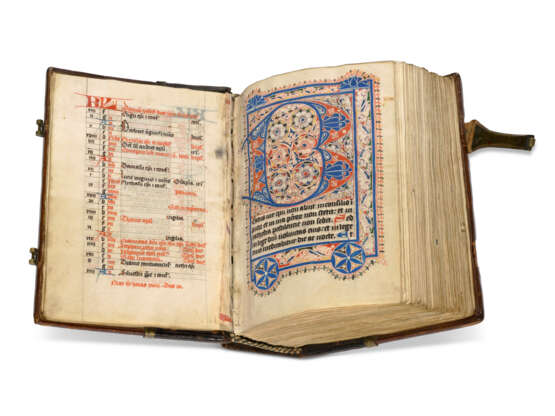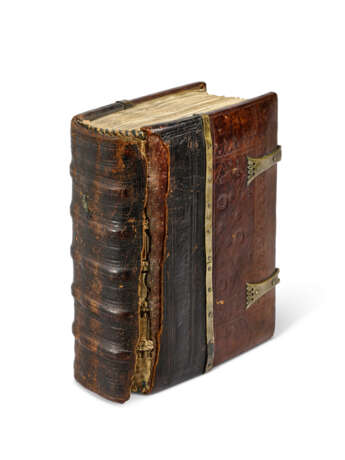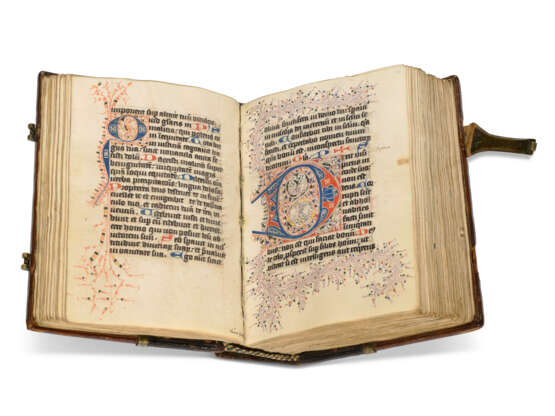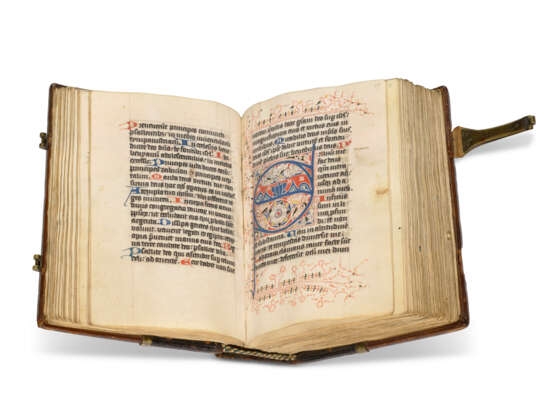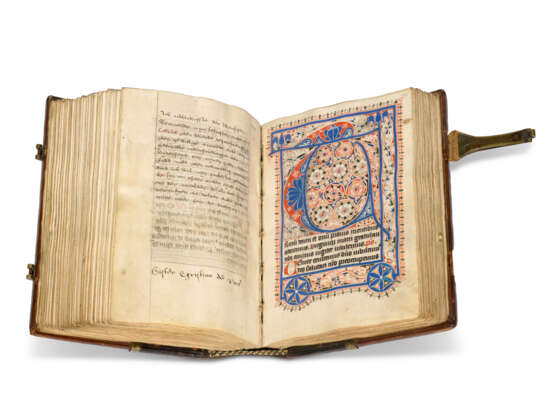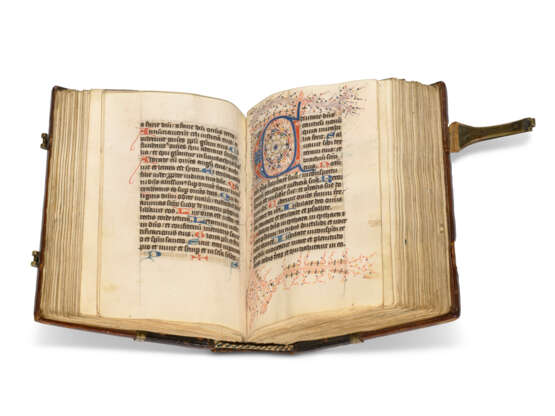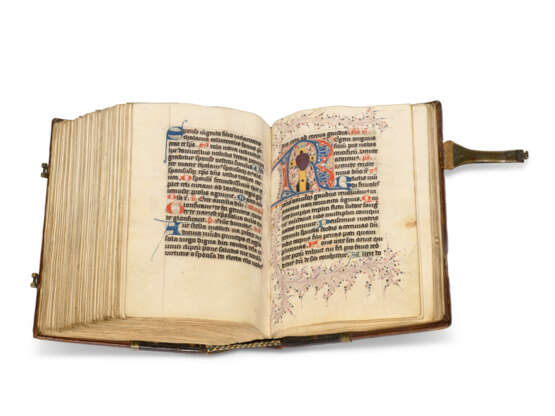ID 1214876
Los 51 | The Rosmalen Breviary
Schätzwert
£ 40 000 – 60 000
Breviary, for the use of Birgittine Nuns, in Latin, decorated manuscript on vellum [Birgittine Abbey of Mariënwater, Rosmalen, Brabant, c.1475]
A finely flourished Breviary for the distinctive use of Birgittine nuns from the Abbey of Mariënwater.
183 x 130 mm. 285 leaves: 16(of 8, lacking i ?cancelled blank and viii with ?devotional diagram), 2-228, 236, 24-358, 369(of 8 + ix), text complete, catchwords and some signatures, 18 lines, ruled space: 111 x 80 mm, rubrics in red, text capitals and cadels touched red, one- and two-line initials alternately in red or blue, line endings in red and blue, two very large initials with elaborate penwork and painted decoration in red, blue, green, yellow and purple framing text and initial, fourteen similar large initials, one with the Sacred Heart nailed to the Cross, with penwork borders to three sides, three similar initials with penwork borders to two sides and two smaller initials with penwork borders to one side (one leaf with ?devotional diagram excised after f.6, slight cockling to a few leaves, light wear to margins).
Binding:
Contemporary binding in brown calf blind stamped with a geometric pattern of double fillets with tools including a fleur de lis, a six petalled flower, an eight pointed star with an outer frame of trefoils, 16th-century rebacking in darker leather blind stamped with a leaf design, extending over upper and lower covers, secured on upper and lower covers with metal strips, two metal clasps and catches (lacking lower metal clasp, upper joint split, wear to lower corners, some later added tabs remaining).
Provenance:
(1) The double abbey of Birgittine (Bridgettine) monks and nuns, the Order of the Most Holy Saviour, of Mariënwater or Coudewater, Maria ad aquas frigidas, at Rosmalen outside ‘s Hertogenbosch, Brabant, founded c.1437, the first Birgittine house in the Netherlands and the only Birgittine Abbey in the diocese of Liege. The Order, founded in 1344 by St Birgitta of Sweden (1303-1373), has its own Use for its nuns, followed here, with a calendar for the diocese of Liège: in red are the canonisation of St Birgitta (7 Oct with her Translation in black 28 May), St Anne totum duplex in ordine nostro, a double feast in our order (26 July), the Bishops of Liège Lambert (17 Sept. with, in black, the octave, his Translation 28 April and Triumph, his relics bringing victory to Liège at the Battle of Steps 1213, 13 Oct) and Hubert (3 Nov). Saints appropriate to the diocese of Liège and Brabant are Boniface (5 June), Theodard (10 Sept.), Rumold (27 Oct), Madelberta (7 Sept.), Oda (24 Oct); in the litany are Sts Lambert, Hubert, Jodocus, Anne, Birgitta, and Dympna. The distinctive decoration is characteristic of Mariënwater, where both monks and nuns copied books for their own use – a practice that continued into modern times – and for elsewhere.
This Breviary was used by generations of sisters, as shown by neat annotations and additions. Inside the upper cover a 16th-century ownership inscription has been largely erased: ‘Dit boek hoert […] (in red) lyden’. On f.180v is the profession signed by Sister Christina de Roos, who professed in 1627 and died in 1670; she seemingly annotated some Psalms. The date 1643 appears on f.198.
Although books may have been lost in the iconoclasm of the 1560s, the community maintained a continuous existence through religious and political upheaval. In 1652 the monks moved to Hoboken and in 1713 the nuns left Mariënwater to found Maria Refugie in Uden. The community survived, despite the plundering of French revolutionary troops in 1794 and Napoleonic attempts at suppression. Before their fortunes revived, the sisters raised funds by selling possessions: their accounts 1807-1828 list six sales which include oude boeken, old books, raising sums indicative of manuscripts or valuable prints. Others remain in their possession today and about sixty earlier Mariënwater manuscripts are known (see U. Sander Olsen, ‘Handschriften uit het Birgittinissenklooster Mariënwater te Rosmalen bij ‘s Hertogenbosch’, Serta devota in memoriam Guillelmi Lourdaux. Pars posterior, 1995, pp.225-254, this ms pp.233, 246; and Bibliotheca Birgittina Birgittinessenabdij Marie͏̈nwater/Maria Refugie; Uden, 2002, this ms p.253).
(2) The library of Dirk Cornelis (1751-1833) and his son Jan Jacob (1791-1869) van Voorst: their sale Amsterdam, Frederik Muller, 27 January 1860, Catalogue raisonné de la précieuse collection […] , 1859, lot 124. Both were ministers of the reformed church, the father a published and prolific theologian and the more likely purchaser. The ‘books of hours’, nos 111-141, are said to have come largely from Mariënwater. A 19th-century hand has written N. 21 in black ink inside the upper cover: similar numbers are found in other Birgittine van Voorst manuscripts (see Kidd, 2001, p.126). Centre below, a different hand has written No 2.
(3) Antonius van der Linde (1833-1897): Catalogue de la bibliothèque de M.A. van der Linde, Brussels, G.-A. Trigt, 16-17 April 1864, lot 216. Antonius van der Linde assembled a large library on a variety of subjects, selling in 1864 those peripheral to his core interests, book history, early printing and bibliography; in 1876 he became librarian of the Landesbibliothek at Wiesbaden.
(4) The Schoenberg database lists this manuscript as having belonged to Ormond G. Smith (1860-1933), founder of the publishers Street and Smith: New York, Parke Bernet Galleries, 23 February 1939, lot 42.
(5) Sotheby’s, 1 December 1987, lot 38: note in pencil inside lower cover.
(6) The Schøyen Collection, MS 39.
Content:
Calendar for the diocese of Liège ff.1-6; the Psalms ff.7-163v: Canticles f.147v, litany f.158v; Office of the Dead, Birgittine Use, f.163v-172v; Hours of the Holy Spirit ff.172v-180; added profession of faith by Sister Christina de Roos f.180v; Office of the Virgin for each day of the week, Birgittine Use, ff.181-285: Sunday Hours with suffrage to St Birgitta f.181, Monday Hours f.197v, Tuesday Hours f.210, Wednesday Hours f.223v, Thursday Hours f.236, Friday Hours f.250, Saturday Hours followed by seasonal variations f.265v; added prayer f.285v.
Birgitta envisaged each Abbey as having a preponderance of nuns, up to sixty, and far fewer monks, twenty-five, to be the essential priests and deacons and lay brothers for manual labour. Their role was, in a sense, to support the nuns, including at Mariënwater a brother specially charged with teaching the sisters Latin so that they could understand the liturgy which filled their lives. The monks followed the full breviary offices of the region of each abbey, recited or chanted before the nuns’ much simpler complementary office, honouring the Virgin, which was different for each day of the week but with comparatively few variations during the year; similarly, the monks followed the local Office of the Dead and the specifically Birgittine Use was for the nuns (see A. Jefferies Collins, The Bridgettine Breviary of Syon Abbey: from the MS. with English rubrics F.4.II at Magdalene College Cambridge, 1969). The three readings for Matins each day, the Angelic Discourses or Sermo angelicus, were dictated to the saint by an angel and then translated into Latin from Birgitta’s Swedish by Master Peter Olafsson of Skänninge (1298-1378), who was responsible for shaping the office and writing the hymns. Central to Birgitta’s vision was the celebration of the Virgin by women throughout each day.
The Birgittine Breviary embodies the exceptional nature of the Order, founded not as female convents, in the wake of male orders, but as double houses of nuns and monks by a woman with a unique view of female spirituality and purpose.
Decoration:
The striking and colourful penwork decoration, with its ‘rivers’ of curving red or purple lines accented with green and/or red and its initials filled with flowers and curling leaf forms, is typical of books from Mariënwater and was presumably evolved in the scriptorium there. Comparable ‘rivers’ are in a more modestly decorated Mariënwater Breviary dated to c.1470 (Leiden, UB, ms BPL 2856). Some pages in the present lot have straighter ‘beaded’ lines leading to a less dense decoration of curving lines with small leaf or flower forms e.g. f.68. Similar decoration is found in a Mariënwater Breviary dated 1468 (The Hague, KB, ms 134 C 60), which shares the full-page design of the openings to the Psalter and the Offices through the week, while incorporating small figures into the borders (see A. Korteweg, Kriezels, Aubergines en Takkenbossen, 1992, nos 153 and 155). The hierarchy of decoration follows the same pattern as the volume dated 1468 in The Hague. The full-page designs mark the two major texts: the Psalms and the Offices for the days of the week, ff.7, 181; the three-sided borders mark the seven subsequent divisions of the Psalms, into the sections to be recited or chanted each day of the week and for Sunday vespers, Ps. 26 f.28v, Ps. 38 f.42, Ps 52 f.55, Ps 68 f.68, Ps 80 f.84, Ps 97 f.99, Ps 109 f.114v, and each Office for the six days from Monday, with the initial for the Friday Hours, the day of the Crucifixion, filled by the wounded heart of Christ on the Cross, ff. 197v, 210, 223v, 236, 250, 265; the two-sided borders signal the Office of the Dead and the first reading in the Sunday hours ff.163v, 183; the borders to one side only introduce Psalm 51, which opened the second section in the earlier three part division of the psalms, the first of the Canticles and the Hours of the Holy Ghost ff. 54v, 147v, 183.
Literature
Kidd, P., Medieval Manuscripts from the Collection of T. R. Buchanan in the Bodleian Library, Oxford, 2001, p.127.
| Herkunftsort: | Belgien, Westeuropa, Europa |
|---|---|
| Kategorie des Auktionshauses: | Handschriften des Mittelalters und der Renaissance, Bücher und Handschriften |
| Herkunftsort: | Belgien, Westeuropa, Europa |
|---|---|
| Kategorie des Auktionshauses: | Handschriften des Mittelalters und der Renaissance, Bücher und Handschriften |
| Adresse der Versteigerung |
CHRISTIE'S 8 King Street, St. James's SW1Y 6QT London Vereinigtes Königreich | |
|---|---|---|
| Vorschau |
| |
| Telefon | +44 (0)20 7839 9060 | |
| Aufgeld | see on Website | |
| Nutzungsbedingungen | Nutzungsbedingungen |
